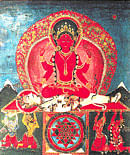
For centuries, artists such as Picasso, Francisco Goya and the Viennese Actionists of the 1960s have pushed the boundary in terms of violent content in art, and challenged what to many would appear obscene or offensive.
Extreme and symbolic acts of violence have also surfaced, time and again, in works of several Indian contemporary artists as well. So pervasive is our fascination with violence that its depiction in art almost becomes a celebration.
Take the case of Osian’s ongoing show at India Habitat Centre, New Delhi, for example. Ironically titled ‘Jashn-Osianama’, the show features work of over 20 Indian contemporary artists that images death and violence among other cultural artefacts.
Indeed, the oldest visual art on record is violent. Research indicates that 30,000 years ago in what is now France, prehistoric artists scratched portraits of dangerous predators and animals of the hunt onto cave walls, shading them in charcoal. Even then, people understood that in order for life to continue, life had to be sacrificed. The Osian’s Delhi offering, almost a poor cousin to what was shown in Mumbai as the show’s first edition, illustrates in short capsule our awkward dance with these darker impulses. The works in the exhibit, taken from Osian’s archive collection are, no doubt, rare but fail to evoke any grand cathartic response as curator Neville Tuli hopes they would.
To begin with, Visual Arts Gallery as a space may be central and happening, but is too small a space and gives a feeling of a hurriedly put-together show. While one is familiar with most of the artists’ works on show, the exhibits that deserved greater space — the awesome Tibetan Thangkas for one — have been relegated to a mere corner. Mahatma Gandhi’s oleograph rubs shoulders with a poster of Clint Eastwood carrying a ultra-deadly Magnum gun in what can be the most ironical juxtaposition in an arts exhibit.
If you can ignore the crammed feeling that overpowers you before you move on to the paintings, the section which really stands out for its novelty is the Japanese Samurai artworks that have rarely been seen. Spanning over seven centuries of history and exemplifying the quality and attention to detail that Japanese warriors and craftsmen paid to their trade, this section leaves you asking for more.
Mainstream art
Struggling for attention, somewhere between the Japanese armours and Indian artists works, are Rajasthani and Pahari miniature paintings, Chittaprosad’s delightful drawings and linocuts and Hollywood memorabilia.
The focus of the show, of course, is on mainstream art — life-size paintings by artists who have been more celebrated for reasons other than depicting violence — FN Souza for erotica, Manjit Bawa for his Sufism, Jamini Roy for folklore…What this section does instead is perhaps, and rightly so, breaks these stereotypes…while Jamini Roy’s ‘Crucifixion’ and Bawa’s ‘The Killing of Safdar Hashmi’ are indeed works of great importance and so is Nandalal Bose’s ‘Shiva’ drinking poison, one wonders if these poignant works can be classified as ‘violent’. Ved Nayar’s ‘The Last Aggression’ and Souza’s ‘Rape’, however, fit confidently into the theme. So do ‘Bangladesh War’ by Rabin Mondal, one of the most unabashed votaries of depicting violence on canvas and ‘Death’ by Ganesh Pyne.
Among the younger artists, there are works by Rekha Rodwittiya, Ranbir Kaleka and Surendran Nair which have a rightful place in the show. While some works, like those of J Sultan Ali, may not have overtly grotesque images, the symbolism is not hard to miss.
Also part of the show is Henry Singleton’s 1799 painting of the fall of Tipu Sultan, an eye-catching oil by Krishen Khanna showing his take on the death of Che Guevara, and photographs by WW Hooper capturing human suffering during the Madras famine.
According to a press release quote, Neville Tuli offers: “Every artist at some stage of their evolution finds a focus on this theme. The ability to absorb the violence of pain, suffering and injustice and then create a symbol of inspiration is at the heart of all artworks in the show. The myth that violent themes inspire violence has to be broken.”
Unfortunately, violence and its depiction is a delicate tightrope walk — between trying to transcend violence and ignoring it altogether; between looking at the horror of violence and fetishing it.
What does this show do? Perhaps a little of both!